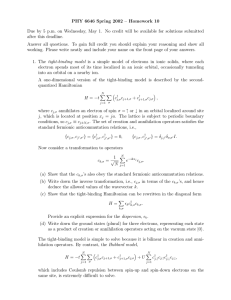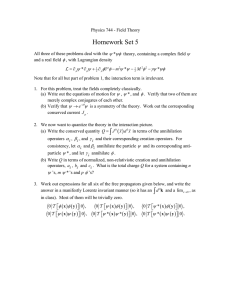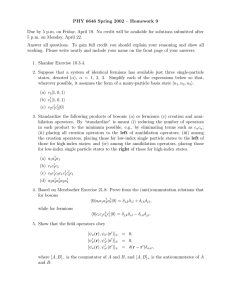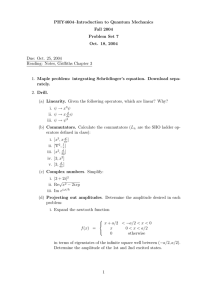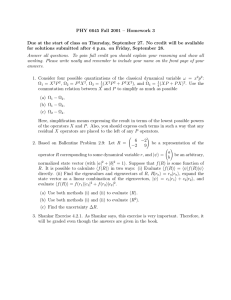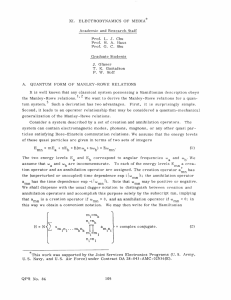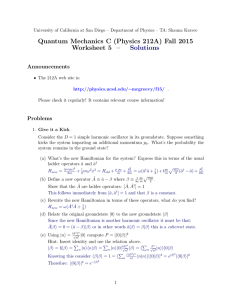PHZ 7427 Spring 2009 – Homework 1
advertisement
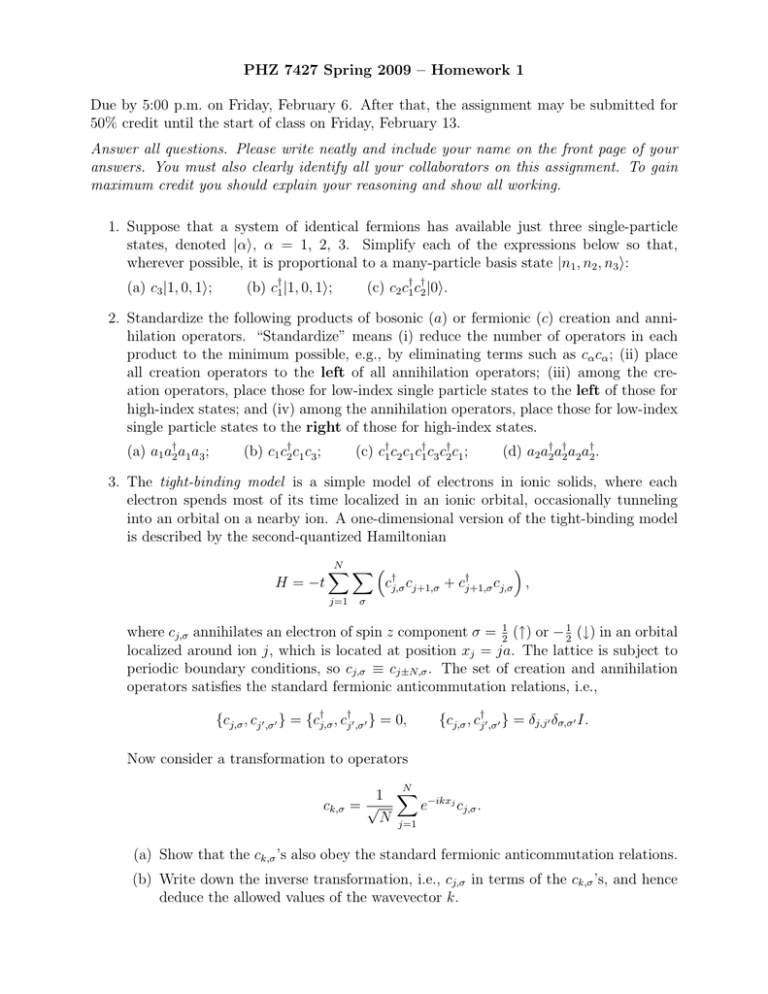
PHZ 7427 Spring 2009 – Homework 1
Due by 5:00 p.m. on Friday, February 6. After that, the assignment may be submitted for
50% credit until the start of class on Friday, February 13.
Answer all questions. Please write neatly and include your name on the front page of your
answers. You must also clearly identify all your collaborators on this assignment. To gain
maximum credit you should explain your reasoning and show all working.
1. Suppose that a system of identical fermions has available just three single-particle
states, denoted |αi, α = 1, 2, 3. Simplify each of the expressions below so that,
wherever possible, it is proportional to a many-particle basis state |n1 , n2 , n3 i:
(a) c3 |1, 0, 1i;
(b) c†1 |1, 0, 1i;
(c) c2 c†1 c†2 |0i.
2. Standardize the following products of bosonic (a) or fermionic (c) creation and annihilation operators. “Standardize” means (i) reduce the number of operators in each
product to the minimum possible, e.g., by eliminating terms such as cα cα ; (ii) place
all creation operators to the left of all annihilation operators; (iii) among the creation operators, place those for low-index single particle states to the left of those for
high-index states; and (iv) among the annihilation operators, place those for low-index
single particle states to the right of those for high-index states.
(a) a1 a†2 a1 a3 ;
(b) c1 c†2 c1 c3 ;
(c) c†1 c2 c1 c†1 c3 c†2 c1 ;
(d) a2 a†2 a†2 a2 a†2 .
3. The tight-binding model is a simple model of electrons in ionic solids, where each
electron spends most of its time localized in an ionic orbital, occasionally tunneling
into an orbital on a nearby ion. A one-dimensional version of the tight-binding model
is described by the second-quantized Hamiltonian
H = −t
N X
X
j=1
c†j,σ cj+1,σ
+
c†j+1,σ cj,σ
,
σ
where cj,σ annihilates an electron of spin z component σ = 12 (↑) or − 12 (↓) in an orbital
localized around ion j, which is located at position xj = ja. The lattice is subject to
periodic boundary conditions, so cj,σ ≡ cj±N,σ . The set of creation and annihilation
operators satisfies the standard fermionic anticommutation relations, i.e.,
{cj,σ , cj 0 ,σ0 } = {c†j,σ , c†j 0 ,σ0 } = 0,
{cj,σ , c†j 0 ,σ0 } = δj,j 0 δσ,σ0 I.
Now consider a transformation to operators
ck,σ
N
1 X −ikxj
=√
e
cj,σ .
N j=1
(a) Show that the ck,σ ’s also obey the standard fermionic anticommutation relations.
(b) Write down the inverse transformation, i.e., cj,σ in terms of the ck,σ ’s, and hence
deduce the allowed values of the wavevector k.
(c) Show that the tight-binding Hamiltonian can be rewritten in the diagonal form
X †
H=
k ck,σ ck,σ .
k,σ
Provide an explicit expression for the dispersion, k .
(d) Write down the ground states (plural) for three electrons, representing each state
as a product of creation or annihilation operators acting on the vacuum state |0i.
The tight-binding model is simple to solve because it is bilinear in creation and annihilation operators. By contrast, the Hubbard model,
H = −t
N X
X
c†j,σ cj+1,σ
j=1
σ
+
c†j+1,σ cj,σ
+U
N
X
c†j,↑ cj,↑ c†j,↓ cj,↓ ,
j=1
which includes Coulomb repulsion between spin-up and spin-down electrons on the
same site, is extremely difficult to solve.
4. Phillips Chapter 5, Problem 3.
